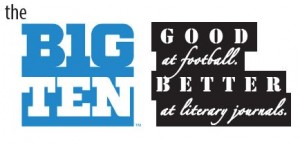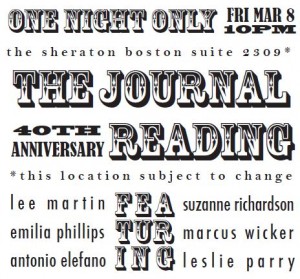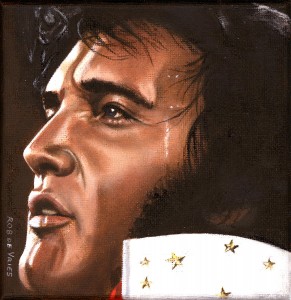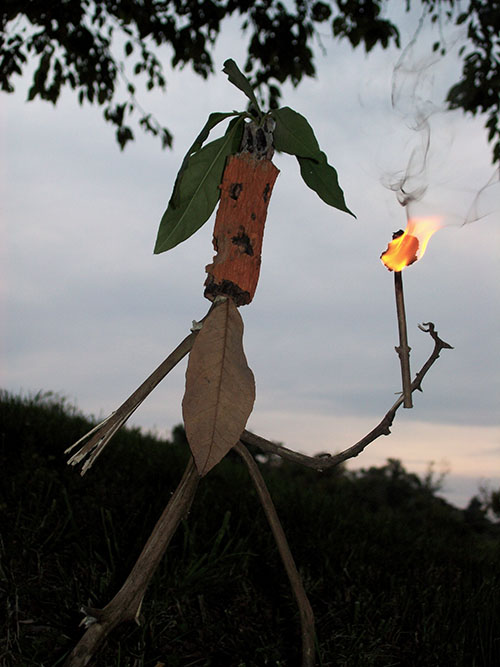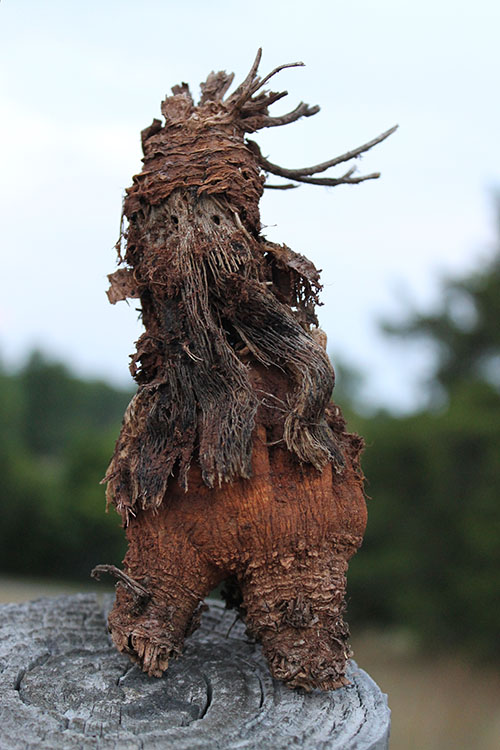Larissa Szporluk is the author of five books of poetry—most recently Traffic with Macbeth (2011). An associate professor of English and Creative Writing at Bowling Green State University, Szporluk has received grants from the Guggenheim Foundation and the National Endowment for the Arts. Her poem “Startle Pattern” appeared in the Spring issue (37.2) of The Journal. Recently, Szporluk spoke with Associate Art Editor Janelle DolRayne regarding the origins of “Startle Pattern,” the roles that narrative and image play within her poetry, and both the unique challenges and opportunities that depression can provide in the landscape of an author’s work.
Janelle DolRayne: I’m glad we get to talk about “Startle Pattern” since it encompasses so much of what I admire about your work. The poem starts at a place of renewal/birth and conceptualizes and mythologizes from that place. Where did this poem begin for you?
Larissa Szporluk: “Startle Pattern” was inspired by a fascinating criminal studies book called Eraser Killers that covers some of the most famous cases of homicides committed by, well, mostly husbands who wanted to “start over” and, being demented and cruel, preferred murder to divorce. Eraser-killing involves making the person disappear completely, which I suppose is part of the “fun.” The Peterson case was so haunting that I still can’t shake it. “Startle Pattern” is just a poetic retelling of the pivotal moment—the case began to unfold once Laci’s fetus washed up on shore. She was nine months pregnant when killed and the fetus did, in fact, emerge from the uterus posthumously. It’s an image beyond myth, beyond all that we’ve read and been told.
JDR: It is an extremely unsettling image. In your eyes, how does the image surpass myth?
LS: I suppose the image surpasses myth by the fact of being real. And, being real, the image has no agenda other than to have happened. There is no comfort, no message, no “purpose” to a dead fetus rising out of an isolated uterus at the bottom of the sea, and yet, because we are instructed by tales of resurrection—the phoenix, Christ, etc.—we want so badly for reality to be positive. We want the miracle of the little boy surfacing alive. We want him to stand trial against his father. We want the triumph, and we’re never going to get it. Perhaps that unrequited yearning for the impossible contributes to the image’s power as well. It’s a distorted renewal/birth but ultimately sad and empty. The distortion isn’t thrilling or instructive. It just is.
JDR: Your poems are extremely intimate. As a reader, I always feel positioned within the mind and body of the poem, never on the periphery. They have an extremely strong internal motion, even when you are writing about and/or through a character. How do you see the relationship and positioning between speaker and reader in your poems?
LS: Once upon a time, I would have said that there is no relationship, that speaker and reader are more or less merged in my mind when I’m writing. I used to write for a reader who was essentially an aspect of the speaker. Now it’s more complicated. After finishing a very difficult prose project, one that involved a total separation of reader and speaker, I doubt I’ll be able to get that unification back. My sense of the reader now is as a cold, faraway planet that I must somehow try to entice. The strong internal motion that you mention depends on the reader being in the know, being attached, even being dragged in some cases. It’s an aggressive stance, I would say, and, yes, intimate too but not always consensual.
JDR: Do you mind talking a little about the prose poem project and your plans for it? Specifically, why did it call for a total separation of reader and speaker?
LS: It’s funny that you say “prose poem project” because that’s what I’m on the verge of writing now. The project I referred to earlier was a prose fiction project (I hesitate to say “novel”) that has been a disaster, of which I’ll spare you the details and head straight to the question.
Trying to write popular fiction (attending to plot, character, pacing, etc.) is such an intricate, mechanical process that there is no room for indulgence. I found myself basking in narrative details that were of no importance whatsoever—in retrospect, they were grotesque in their gratuitousness. Upon learning that all my efforts had no value, well, you can imagine. Ouch. It was a slap to the soul. Poetry, mine anyway, has always lived in that indulgence; my prose dies in it.
I signed up for the Tupelo 30/30 that begins June 1st and involves writing a new poem every day for that month. I plan to apply this separation strategy to short prose poems. My imagined reader, as separate as they come, is a cold-blooded, poetry-hating grouch.
JDR: In your work, you recreate myth by responding to mythology such as The Adventures of Pinocchio, the biblical Fall, and Macbeth. How responsible do you feel to the original myth when recreating it? How do you see the relationship between old and new mythology in your work?
LS: The Pinocchio poems tried to stay true to the original story and aimed merely to accentuate the images that I found to be most poignant. I would never try that again. It was discouraging because only too late in the project did I realize that I was being a pest and, by then, I had already spent a couple years on the poems and was under pressure to publish a book to get tenure, etc., so there really was no turning back.
I’m not ashamed of the poems but of the impulse. There was no need for that story to be picked at; the poignancy is blatant. But I did come away with a lesson: image is empty without narrative. It’s the difference in power between a blue goat and the blue goat. Which is more interesting?
JDR: At first, I had my mind made up about my answer: the blue goat. But then I thought that a blue goat indicates that the speaker is creating a world in which blue goats are common, which excites me. But I suppose that is an argument for creating narratives within images as well, so I’m going to stick with my first answer: the blue goat.
But thanks for sharing that lesson with us. I’m curious: how has your relationship with image-driven poetry changed since learning this lesson? Both the reading and writing of poetry? Does it still have a place for you?
LS: I’m a lot less patient now. I’m more frightened. I wish it were the opposite, that aging had made me more patient and secure. Unfortunately, it didn’t go that way. I’m paranoid about superficiality, and if an image doesn’t grind or pierce immediately, I dismiss it. As mentioned above, I understand the role of narrative more, so I work to inject the weight of story into nearly every image—key word: “work.” Writing imagistic poetry has become more difficult, more laborious, because “story” has to be created before the language work can begin.
Also, because of the fear. It’s like I know there’s a deeper poem in any given gathering of words, and I’m afraid of not getting there because the only access to it is through abuse—beating and squeezing those words until they actually mean something. Now, of course, that’s perverse, but that’s how it’s been.
Even “Startle Pattern,” which was working from a true story and therefore required little imagination on my part, had to be reconfigured a thousand times, and I’m still not pleased. The ending is a little too gentle. I didn’t get “under” the comber. He’s just a prop.
JDR: From what I understand, you split your time between northern Ohio and northern Italy. There are traces of Italy in The Wind, Master Cherry, The Wind and of Ohio in Traffic with Macbeth. How do these two places enter into your work and process?
LS: I haven’t really begun to explore the impact of northern Italy yet. The Italian influence in Master Cherry was connected to Lombardy, where my husband’s family is from and which is uncannily like northwest Ohio. When they moved to Domodossola in 2006 (a small city in the Lepontine alps), my first thought was: I want to die here. Maybe that’s just middle-age sentiment, but it’s also a beautiful feeling to go running around feeling so happy that you want to die.
I don’t feel that way in Ohio. They’re geographic opposites. Here (I’m in Domodossola right now), there is no horizon. Everything is vertical. The only way out is up. Whereas in northwest Ohio, you’re hard-pressed to find a bump. Everywhere you go, it all comes with you, and it never ends. I like the two extremes. They’re emotional platforms.
I tell students who are depressed or having the “block” that depression has its own music. They should write no matter what and not think they have to be “high” to write good poems. Philip Larkin’s “High Windows” comes from a deep, flat place. He’s brooding and the brooding gives way to a kind of mental chutes-and-ladders. Depressed, he has to create all those altitudes in order to move the poem along. When the poet is already “up,” the poem can be restricted by a reluctance to descend. There is something courageous about flatness, strange as it sounds.
JDR: Not strange at all! I moved to Ohio after growing up in the Rockies and spending time in California, so this really resonates. I think the difficult part is to find a way to begin out of flatness. You can’t rely on gravity to take you somewhere. How do you manage to ignore the difficulties of flatness and to build altitudes in your poems out of flatness?
LS: But you can rely on gravity—you can keep going down. That’s the only benefit of depression—you’re closer to the depths. I’m not talking about mystical meditation-induced depths. I’m talking about mentally disturbed ones. That’s where the energy is to build the altitudes you’re talking about; put simply, you scare yourself out of the flatness!
OK, now it’s getting convoluted. I’ll start over: You’re in the flatness. Your mind is flat. You’re precisely numb with your own ennui. It’s only in that state that you feel the pull from below, a kind of Swedenborgian lower spirit telling you that you’re nothing, you’re a loser, you’re hopeless. So you agree. And when you agree, you’re pulled even further into a whirlpool of suicidal whisperings and bad feelings. And then—there it is—you either do yourself in or you become a hero.
Of course, we’re talking about writing a poem, right? So what is your “weapon?” Words, of course, and suddenly the words come to your rescue, and they’re loaded with God or whatever feels almighty to you, and they’re strong because, no, you’re not going to surrender to the lower spirits. It’s too easy to just crumble and self-annihilate, too easy and stupid, so the energy starts building, the will to live returns, and the rhythms start climbing and pulling you up and up. Pretty soon, you’re not only out of hell but beyond the flatness and getting so high now that not even the words can keep up and, as in the Larkin poem, the image steps in, the deep image that represents the narrative you’ve just been through—high windows—salvation of the highest kind, relief in endlessness, the summit.
Unfortunately, this psychodrama is both necessary for the poem and exhausting for the poet. I no longer believe that the altitudes live in the words alone. The psychotic spirit (or the lucky, healthy one) has to tryst first with itself and then with the language in order to make everything rise.

